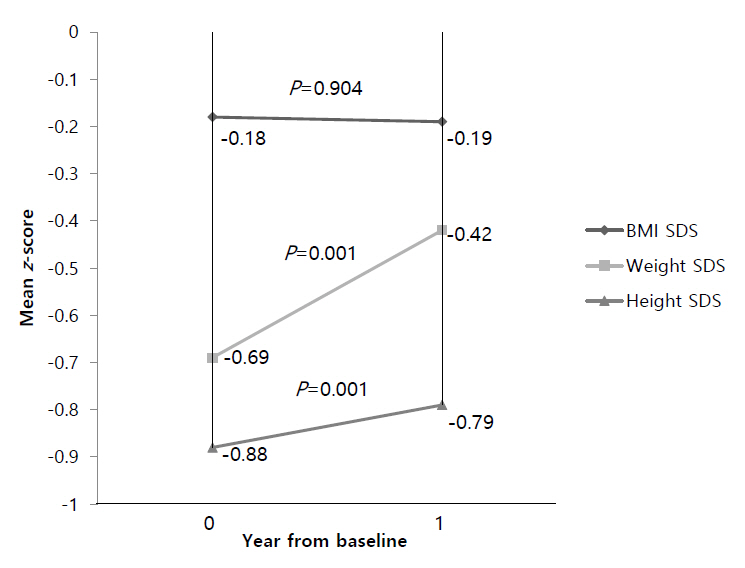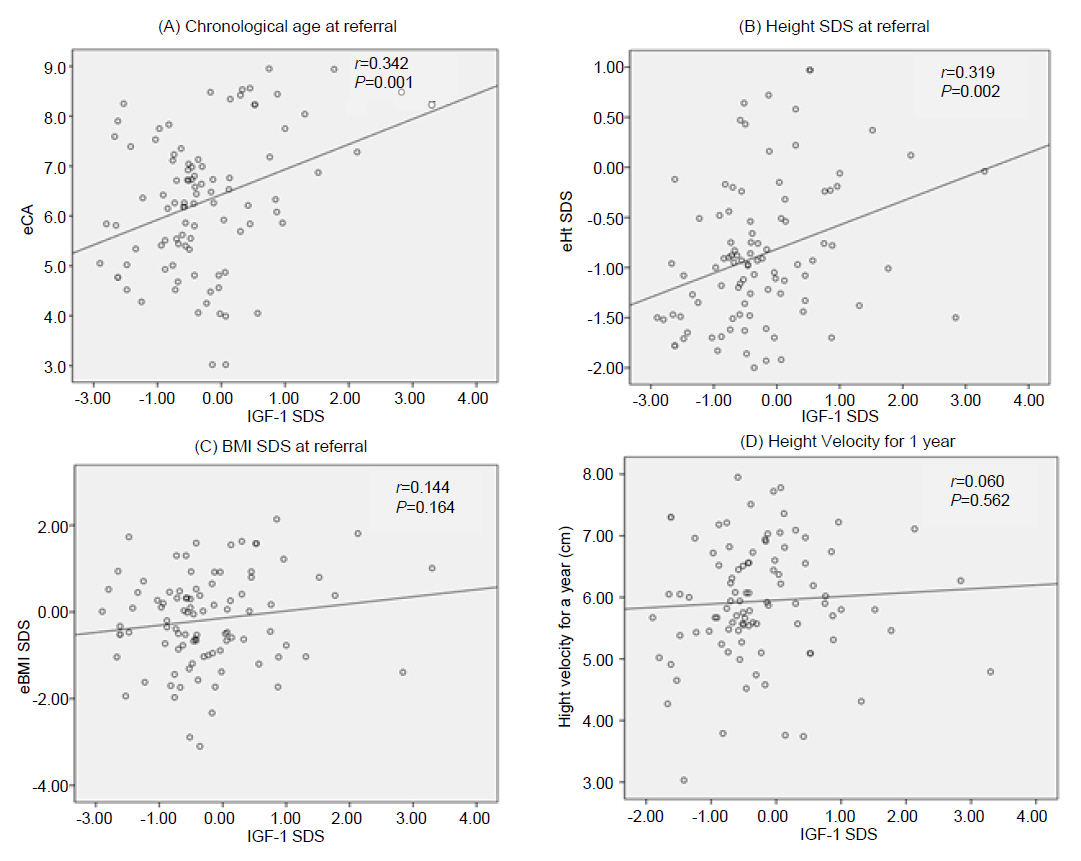Ann Pediatr Endocrinol Metab.
2018 Sep;23(3):148-153. 10.6065/apem.2018.23.3.148.
Factors affecting height velocity in normal prepubertal children
- Affiliations
-
- 1Department of Pediatrics, College of Medicine, The Catholic University of Korea, Seoul, Korea. jmhpe@catholic.ac.kr
- KMID: 2422479
- DOI: http://doi.org/10.6065/apem.2018.23.3.148
Abstract
- PURPOSE
To analyze the effects of clinical and laboratory factors, including insulin-like growth factor (IGF) levels, on the height velocity of normal prepubertal children.
METHODS
Ninety-five healthy prepubertal children (33 boys, 62 girls) were enrolled. The mean chronological age was 6.3±1.4 years, with a height standard deviation score (SDS) of -0.88±0.70. IGF-1, IGF binding protein-3 (IGFBP-3), SDS for anthropometric measurements, and changes in SDS for anthropometric measurements were analyzed for 1 year, and their associations with 1-year height velocity were investigated.
RESULTS
The group of children with a 1-year height velocity of ≥6 cm were chronologically younger than the group with a 1-year height velocity of < 6 cm (5.9±1.3 years vs. 6.7±1.3 years, P=0.004), with a lesser increase of SDS for body mass index (BMI) over 1 year (-0.18±0.68 vs. 0.13±0.53, P=0.014). There were no differences between the 2 groups in IGF-1 SDS and IGFBP-3 SDS. Multiple linear regression showed that baseline chronological age (r=0.243, P=0.026) and height SDS (r=0.236, P=0.030) were positively associated with IGF-1 SDS. Binomial logistic regression showed that an older chronologic age at referral (odds ratio [OR], 0.68; 95% confidence interval [CI], 0.47-0.99) and an increase of BMI SDS over 1 year (OR, 0.41; 95% CI, 0.18-0.89) were associated with a decreased growth possibility of an above-average height velocity (≥6 cm/yr).
CONCLUSIONS
Height velocity of normal prepubertal children is affected by an increase of BMI SDS and chronological age. Prepubertal IGF-1 SDS reflects height SDS at the time of measurement but is not associated with subsequent height velocity.
MeSH Terms
Figure
Cited by 1 articles
-
Influences of Socioeconomic Status on Short Stature in Childhood
Sun Bok Suh, Hyung Su Kim
Kosin Med J. 2020;35(1):15-25. doi: 10.7180/kmj.2020.35.1.15.
Reference
-
References
1. Himes JH, Roche AF, Thissen D, Moore WM. Parent-specific adjustments for evaluation of recumbent length and stature of children. Pediatrics. 1985; 75:304–13.
Article2. WHO Multicentre Growth Reference Study Group. WHO Child Growth Standards based on length/height, weight and age. Acta Paediatr Suppl. 2006; 450:76–85.3. Stenhouse E, Wright DE, Hattersley AT, Millward A. The accuracy of birth weight. J Clin Nurs. 2004; 13:767–8.
Article4. Gluckman PD, Hanson M, Zimmet P, Forrester T. Losing the war against obesity: the need for a developmental perspective. Sci Transl Med. 2011; 3:93.
Article5. Dewey KG, Peerson JM, Brown KH, Krebs NF, Michaelsen KF, Persson LA, et al. Growth of breast-fed infants deviates from current reference data: a pooled analysis of US, Canadian, and European data sets. World Health Organization Working Group on Infant Growth. Pediatrics. 1995; 96(3 Pt 1):495–503.6. Risnes KR, Vatten LJ, Baker JL, Jameson K, Sovio U, Kajantie E, et al. Birthweight and mortality in adulthood: a systematic review and meta-analysis. Int J Epidemiol. 2011; 40:647–61.
Article7. Rogol AD, Clark PA, Roemmich JN. Growth and pubertal development in children and adolescents: effects of diet and physical activity. Am J Clin Nutr. 2000; 72(2 Suppl):521S–528S.
Article8. Tanner JM. Fetus into man: physical growth from conception to maturity. Cambridge (MA): Harvard University Press;1989.9. Roemmich JN, Rogol AD. Exercise and growth hormone: does one affect the other? J Pediatr. 1997; 131(1 Pt 2):S75–80.
Article10. Wideman L, Weltman JY, Hartman ML, Veldhuis JD, Weltman A. Growth hormone release during acute and chronic aerobic and resistance exercise: recent findings. Sports Med. 2002; 32:987–1004.
Article11. Haspolat K, Ece A, Gürkan F, Atamer Y, Tutanç M, Yolbaş I. Relationships between leptin, insulin, IGF-1 and IGFBP-3 in children with energy malnutrition. Clin Biochem. 2007; 40:201–5.
Article12. He Q, Karlberg J. Bmi in childhood and its association with height gain, timing of puberty, and final height. Pediatr Res. 2001; 49:244–51.
Article13. Vignolo M, Naselli A, Di Battista E, Mostert M, Aicardi G. Growth and development in simple obesity. Eur J Pediatr. 1988; 147:242–4.
Article14. Holmgren A, Niklasson A, Nierop AF, Gelander L, Aronson AS, Sjöberg A, et al. Pubertal height gain is inversely related to peak BMI in childhood. Pediatr Res. 2017; 81:448–54.
Article15. Sklar CA, Rothenberg S, Blumberg D, Oberfield SE, Levine LS, David R. Suppression of the pituitary-gonadal axis in children with central precocious puberty: effects on growth, growth hormone, insulin-like growth factor-I, and prolactin secretion. J Clin Endocrinol Metab. 1991; 73:734–8.
Article16. Ahmed SF, Farquharson C. The effect of GH and IGF1 on linear growth and skeletal development and their modulation by SOCS proteins. J Endocrinol. 2010; 206:249–59.
Article17. Moon JS, Lee SY, Nam CM, Choi JM, Choe BK, Seo JW, et al. 2007 Korean National Growth Charts: review of developmental process and an outlook. Korean J Pediatr. 2008; 51:1–25.
Article18. Marshall WA, Tanner JM. Growth and physiological development during adolescence. Annu Rev Med. 1968; 19:283–300.
Article19. Hyun SE, Lee BC, Suh BK, Chung SC, Ko CW, Kim HS, et al. Reference values for serum levels of insulin-like growth factor-I and insulin-like growth factor binding protein-3 in Korean children and adolescents. Clin Biochem. 2012; 45:16–21.
Article20. Cohen P, Germak J, Rogol AD, Weng W, Kappelgaard AM, Rosenfeld RG, et al. Variable degree of growth hormone (GH) and insulin-like growth factor (IGF) sensitivity in children with idiopathic short stature compared with GH-deficient patients: evidence from an IGF-based dosing study of short children. J Clin Endocrinol Metab. 2010; 95:2089–98.
Article21. Alawneh H, Khaledi O, Maita J, Fugaha N. Insulin like growth factor 1 as an indicator of growth hormone deficiency. J Res Med Sci. 2015; 22:13–7.
Article22. Cole TJ, Ahmed ML, Preece MA, Hindmarsh P, Dunger DB. The relationship between Insulin-like Growth Factor 1, sex steroids and timing of the pubertal growth spurt. Clin Endocrinol (Oxf). 2015; 82:862–9.
Article23. Nilsson O, Marino R, De Luca F, Phillip M, Baron J. Endocrine regulation of the growth plate. Horm Res. 2005; 64:157–65.
Article24. Wang X, Xing KH, Qi J, Guan Y, Zhang J. Analysis of the relationship of insulin-like growth factor-1 to the growth velocity and feeding of healthy infants. Growth Horm IGF Res. 2013; 23:215–9.
Article25. Yackobovitch-Gavan M, Lebenthal Y, Lazar L, Shalitin S, Demol S, Tenenbaum A. Effect of nutritional supplementation on growth in short and lean prepubertal children after 1 year of intervention. J Pediatr. 2016; 179:154–9. e1.
Article26. WOLFF OH. Obesity in childhood; a study of the birth weight, the height, and the onset of puberty. Q J Med. 1955; 24:109–23.27. Cheek DB, Schultz RB, Parra A, Reba RC. Overgrowth of lean and adipose tissues in adolescent obesity. Pediatr Res. 1970; 4:268–79.
Article28. Tanner JM, Goldstein H, Whitehouse RH. Standards for children's height at ages 2-9 years allowing for heights of parents. Arch Dis Child. 1970; 45:755–62.29. Nam SY, Lee EJ, Kim KR, Cha BS, Song YD, Lim SK, et al. Effect of obesity on total and free insulin-like growth factor (IGF)-1, and their relationship to IGF-binding protein (BP)-1, IGFBP-2, IGFBP-3, insulin, and growth hormone. Int J Obes Relat Metab Disord. 1997; 21:355–9.
Article30. Tanner JM, Whitehouse RH, Marshall WA, Carter BS. Prediction of adult height from height, bone age, and occurrence of menarche, at ages 4 to 16 with allowance for midparent height. Arch Dis Child. 1975; 50:14–26.
Article31. Satoh M. Bone age: assessment methods and clinical applications. Clin Pediatr Endocrinol. 2015; 24:143–52.
Article
- Full Text Links
- Actions
-
Cited
- CITED
-
- Close
- Share
- Similar articles
-
- Growth and Metabolic Consequences in Children Born with Small for Gestational Age at Term Gestation
- Factors Affecting on Final Adult Height and Total Height Gain in Children with Idiopathic and Organic Growth Hormone Deficiency after Growth Hormone Treatment
- Effectiveness of growth hormone therapy in children with Noonan syndrome
- Growth in Children with Growth Hormone Deficiency Following Surgery for Craniopharyngioma
- Growth Promoting Factors Which Affect Final Adult Height



